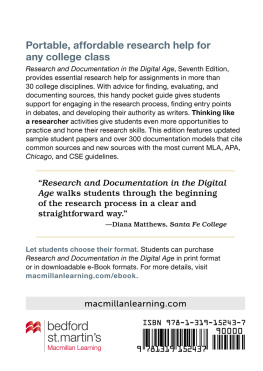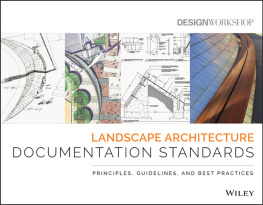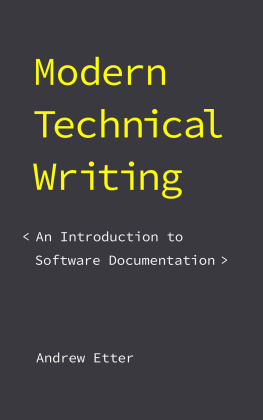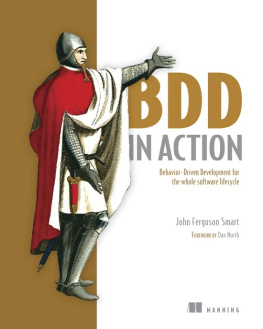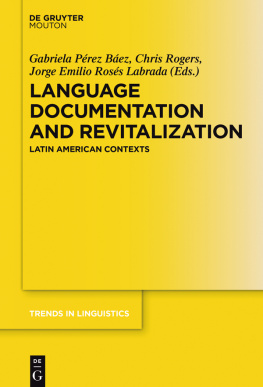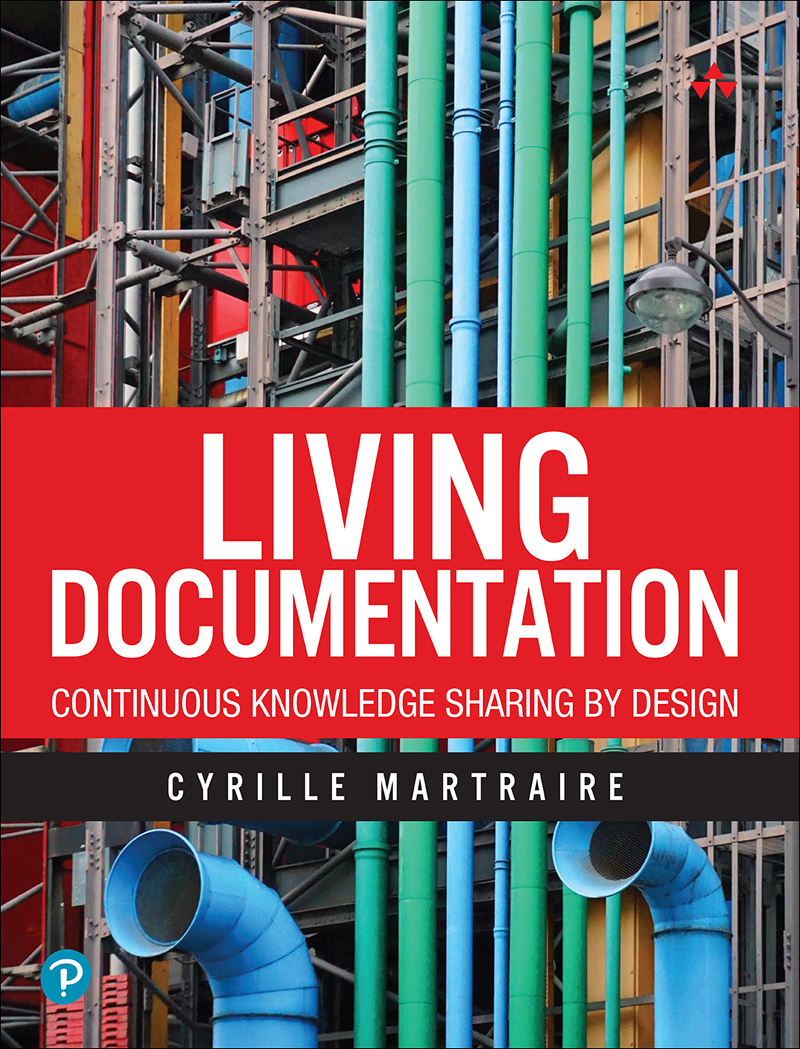ePUB is an open, industry-standard format for eBooks. However, support of ePUB and its many features varies across reading devices and applications. Use your device or app settings to customize the presentation to your liking. Settings that you can customize often include font, font size, single or double column, landscape or portrait mode, and figures that you can click or tap to enlarge. For additional information about the settings and features on your reading device or app, visit the device manufacturers Web site.
Many titles include programming code or configuration examples. To optimize the presentation of these elements, view the eBook in single-column, landscape mode and adjust the font size to the smallest setting. In addition to presenting code and configurations in the reflowable text format, we have included images of the code that mimic the presentation found in the print book; therefore, where the reflowable format may compromise the presentation of the code listing, you will see a Click here to view code image link. Click the link to view the print-fidelity code image. To return to the previous page viewed, click the Back button on your device or app.
Living Documentation
Continuous Knowledge Sharing by Design
Cyrille Martraire
Boston Columbus New York San Francisco Amsterdam Cape Town
Dubai London Madrid Milan Munich Paris Montreal Toronto Delhi
Mexico City So Paulo Sydney Hong Kong Seoul Singapore Taipei Tokyo
Many of the designations used by manufacturers and sellers to distinguish their products are claimed as trademarks. Where those designations appear in this book, and the publisher was aware of a trademark claim, the designations have been printed with initial capital letters or in all capitals.
The author and publisher have taken care in the preparation of this book, but make no expressed or implied warranty of any kind and assume no responsibility for errors or omissions. No liability is assumed for incidental or consequential damages in connection with or arising out of the use of the information or programs contained herein.
For information about buying this title in bulk quantities, or for special sales opportunities (which may include electronic versions; custom cover designs; and content particular to your business, training goals, marketing focus, or branding interests), please contact our corporate sales department at or (800) 382-3419.
For government sales inquiries, please contact .
For questions about sales outside the U.S., please contact .
Visit us on the Web: informit.com/aw
Library of Congress Control Number: 2019936806
Copyright 2019 Pearson Education, Inc.
All rights reserved. This publication is protected by copyright, and permission must be obtained from the publisher prior to any prohibited reproduction, storage in a retrieval system, or transmission in any form or by any means, electronic, mechanical, photocopying, recording, or likewise. For information regarding permissions, request forms and the appropriate contacts within the Pearson Education Global Rights & Permissions Department, please visit www.pearsoned.com/permissions/.
ISBN-13: 978-0-13-468932-6
ISBN-10: 0-13-468932-1
1 19
Publisher
Mark L. Taub
Development Editor
Chris Zahn
Managing Editor
Sandra Schroeder
Senior Project Editor
Tonya Simpson
Copy Editor
Kitty Wilson
Indexer
Erika Millen
Proofreader
Linda Morris
Technical Reviewers
Rebecca Wirfs-Brock
Woody Zuill
Steve Hayes
Editorial Assistant
Cindy Teeters
Cover Designer
Chuti Prasertsith
Compositor
codeMantra
Graphics
Yunshan Xia
For my wife, Yunshan, and our children, Norbert and Gustave.
Acknowledgments
First, Id like to give special thanks my official reviewers, Rebecca Wirfs-Brock, Steve Hayes, and Woody Zuill, for the insightful review of the manuscript in a very short period of time, which really helped improve and organize the material better.
Many thanks to the Pearson team, starting with Chris Zahn, the developmental editor Ive been lucky to work with regularly, Mark Taub, publisher, who led the whole publishing process, Kitty Wilson for the meticulous copy editing, and Tonya Simpson, it was a pleasure working with you throughout the project. I also want to thank Chris Guzikowski, executive editor, for signing the book at Pearson back in 2016.
The ideas in this book originate from people I respect a lot. Dan North, Chris Matts, and Liz Keogh derived the practice called behavioral driven development (BDD), which is one of the best examples of living documentation at work. Eric Evans, in his book Domain-Driven Design, proposed many ideas that, in turn, inspired BDD. Gojko Adzic proposed the term living documentation in his book Specification by Example. In this book, I elaborate on these ideas and generalizes them to other areas of a software project. DDD has emphasized how the thinking evolves during the life of a project, and its proponents have proposed unifying the domain model and code. Similarly, this book suggests unifying project artifacts and documentation.
The patterns movement and its authors, starting with Ward Cunningham and Kent Beck, have made it increasingly obvious that it is possible to do better documentation by referring to patterns, those already published or presented at Pattern Languages of Programs (PLoP) conferences.
Pragmatic Programmers, Martin Fowler, Ade Oshyneye, Andreas Rping, Simon Brown, and many other authors have distilled nuggets of wisdom on how to do better documentation, in a better way. Rinat Abdulin first wrote on living diagrams and, indeed, coined the term. Thanks to you all of you!
Eric Evans, thanks for all the discussions, usually not on this book, and for your advice.
I would also like to thank Brian Marick for sharing his own work on visible workings with me. As encouragement matters, discussions with Vaughn Vernon and Sandro Mancuso on writing a book did help me, so thanks, guys!
Some discussions are more important than others; especially important are those that generate new ideas, lead to better understanding, or are just exciting. Thanks to George Dinwiddie, Paul Rayner, Jeremie Chassaing, Arnauld Loyer, and Romeu Moura for all the exciting discussions and for sharing your own stories and experiments.
Through the writing of this book, I looked for ideas and feedback as much as I could, particularly during open-space sessions at software development conferences. Maxime Sanglan gave me the first encouraging feedback, along with Franziska Sauerwein. Thanks, Franzi and Max! I want to thank all the participants of the sessions I have run on living documentation at these conferences and unconferences, such as in Agile France, Socrates Germany, Socrates France, Codefreeze Finland, and the Meetup Software Craftsmanship Paris round tables and several Jams of Code at Arolla in the evening.
I had been giving talks at conferences for some time but always concerning practices that are already widely accepted in our industry. With more novel content like living documentation, I also had to test acceptance from various audiences, and I thank the first conferences that took the risk of select the topic: NCrafts in Paris, Domain-Driven Design eXchange in London, Bdx.io in Bordeaux, and ITAKE Bucharest. Thanks for hosting the first versions of the talk or workshop. It was very helpful to have great feedback to inspire more effort to create the book.




